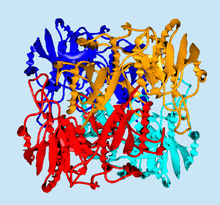User:Riggs2/article notes
 | |
| Clinical data | |
|---|---|
| Trade names | Erwinaze (US), Erwinase (UK) |
| Routes of administration | Injection, intramuscular |
| ATC code | |
| Legal status | |
| Legal status |
|
| Pharmacokinetic data | |
| Elimination half-life | 15.8 hrs |
| Identifiers | |
| |
| Chemical and physical data | |
| Formula | C1377H2208N382O442S17 |
| Molar mass | 31731.9 g/mol g·mol−1 |
| | |
Asparaginase Erwinia chrysanthemi (sold under the brand name Erwinaze (US), Erwinase (UK)), a cancer drug, is an asparaginase enzyme that decreases the level of asparagine present in the bloodstream. By decreasing the level of asparagine, the enzyme is able to inhibit the growth of cancer cells in Acute Lymphoblastic Leukemia patients. Unlike other asparaginases which are derived from E. coli (brand names Elspar or Oncaspar), Asparaginase Erwinia chrysanthemi (brand name Erwinaze), is derived from Erwinia chrysanthemi, a close relative of E. coli. Erwinaze was developed in response to patients who expressed hypersensitivity to E. coli products. [1]
Patients who switched to Erwinaze experienced similar outcomes to patients who continued with Elspar or Oncaspar. [2] [3] Major side effects of Asparaginase Erwinia chrysanthemi include hypersensitivity, pancreatitis, hyperglycemia, thrombosis, and hemorrhage. [4] The drug was developed by EUSA Pharma, and was FDA approved for U.S. patients in November, 2011 under the tradename Erwinaze. [1]
Use in Acute Lymphoblastic Leukemia patients[edit]
Asparaginase Erwinia chrysanthemi is used in a treatment plan for Acute Lymphoblastic Leukemia (ALL) patients who are allergic to E. coli derived asparaginase. Approximately 15-20 percent of ALL patients develop hypersensitivity to E. coli asparaginase during their course of treatment. This results in approximately 450-600 children per year that need an alternative drug to complete their treatment, and the development of Erwinaze now allows patients to complete it. A clinical trial showed that 100 percent of patients who switched to Erwinaze had effective levels of asparaginase in their bloodstream, thus ALL cells were continually prevented from growth. [5]
Additional studies[edit]
Two additional clinical trials support the effectiveness of Erwinase in ALL patients.
Vrooman et al, Pediatric Blood Cancer 2010[2][edit]
The study included 173 children who never became allergic to Elspar and 42 children who did become allergic to Elspar. Those that were allergic were switched to Erwinaze for the remainder of treatment. 81 percent of Elspar users and 85 percent of Erwinaze users experienced no ALL relapses during a 5 year span.
Panosyan et al, Journal of Pediatric Hematology/Oncology 2004[3][edit]
The study included 57 children who never became allergic to Elspar and 42 children who did become allergic to Elspar. Those that were allergic switched to Erwinaze just as in the Vrooman study. In this case 95 percent of Elspar users and 96 percent of Erwinaze users experienced no ALL relapses during a 30 month span.
The 3 asparaginase drugs for ALL treatment[6][edit]
Elspar: Unmodified asparaginase derived from E. coli
Oncaspar: Pegylated asparaginase derived from E. coli
Erwinaze: Unmodified asparaginase dervied from Erwinia chrysanthemi
Mechanism of action[edit]

The L-asparaginase from Erwinia chysanthemi reacts with aspartic acid (asparagine) by hydrolyzing the amide group to form L-aspartate and ammonium. [6]
Dosage and administration[edit]
The recommended dosage depends upon whether the previous drug used was pegaspargase (Oncaspar) or unmodified E. coli asparaginase (Elspar). For Oncaspar, 25,000 International Units is administered intramuscularly once for every 6 previously planned pegaspargase doses. For Elspar, 25,000 International Units is administered intramuscularly once for every one previously planned Elspar dose. [4]
Adverse effects[edit]
Common side effects include throat tightness, breathing difficulties, pancreatitis, glucose intolerance, thrombosis, and hemorrhages. Erwinaze is not known to interact with any other drugs, nor have there been any cases of overdose.[4] It should be noted that some patients who develop hypersensitivity to Elspar may carry that hypersensitivity over to Erwinaze, if the reaction is due to the unmodified asparaginase itself and not to the E. coli products. For these specific patients, Oncaspar, which contains the modified pegylated asparaginase, can be tried. [6]
Major side effects[4][edit]
Hypersensitivity 18%
Pancreatitis 24%
Thrombosis 2%
Hemorrhage 1%
History of drug[edit]
Asparaginase was discovered as a method of cancer treatment in the United Kingdom in the 1950s. [6] Due to antibody production from Elspar and Oncaspar, however, an alternative was needed. Asparaginase Erwinia chrysanthemi was developed by EUSA Pharma, a European oncology pharmaceutical company founded in 2006. The drug has been sold under the trade name Erwinase in countries throught Europe and in Canada. FDA approval was reached November 18, 2011, with the drug under the name Erwinaze in the U.S. market. Erwinaze is designated as an orphan drug. [1]
References[edit]
- ^ a b c U.S. Food and Drug Administration. U.S. Department of Health and Human Services. FDA Approves Erwinaze to Treat a Form of Leukemia. FDA U.S. Food and Drug Administration. 18 Nov. 2011. Web. 1 Dec. 2011.
- ^ a b Vrooman LM, Supko JG, Neuberg DS et al. Pediatr Blood Cancer 2010;54:199–205.
- ^ a b Panosyan EH et al. J Pediatr Hematol Oncol 2004;26:217–226.
- ^ a b c d EUSA Pharma. Erwinaze Prescribing Information. Nov. 2011. Web 03 Dec. 2011.
- ^ FDA Approves EUSA'A Orphan Drug ERWINAZE for Acute Lymphoblastic Leukemia. News Medical. News-Medical.Net, 19 Nov. 2011. Web. 1 Dec. 2011.
- ^ a b c d Avramis, Vassilios I., Sagrario Martin-Aragon, Earl V. Avramis, and Barbara L. Asselin. Pharmacoanalytical Assays of Erwinia Asparaginase (Erwinase) and Pharmacokinetic Results in High-risk Actue Lymphoblastic Leukemia (HR ALL) Patients: Simulations of Erwinase Population PK-PD Models. ANTICANCER RESEARCH 27.4C (2007): 2561-572.
